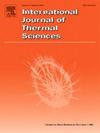The effect of using circular and porous circular fins on the thermal performance of a shell and helically coiled heat exchanger: A numerical and experimental study
IF 4.9
2区 工程技术
Q1 ENGINEERING, MECHANICAL
International Journal of Thermal Sciences
Pub Date : 2025-04-02
DOI:10.1016/j.ijthermalsci.2025.109894
引用次数: 0
Abstract
A novel form of shell and helically coiled heat exchangers, which are widely employed in many applications, have been experimentally and numerically investigated in this work. In the current work, it is aimed to use a cost-effective and simple approach for improving heat transfer in a shell and helically coiled heat exchanger. Accordingly, a shell and helically coiled tube heat exchanger has been modified with a guiding tube and circular fins with the aim of guiding cold flow over the helically coil for enhancing heat transfer rate. In the first step of the study, numerical analyses have been conducted in order to reveal the impact of new modification on the heat transfer. In the next step, a modified heat exchanger with guiding tubes and circular fins has been manufactured and experimentally examined with water and ZnFe2O4/water magnetic nanofluid at different working conditions. The overall results of this study demonstrated how well the modified heat exchanger with circular fins and a guiding tube was designed. Adding a guiding tube into the shell part of the heat exchanger led to moderate the fluid flow and circular fins distributed the flow over the coil which upgraded heat transfer. Experimentally obtained results showed that using ZnFe2O4/water nanofluid in the SHCHE averagely upgraded the heat transfer coefficient as 12.4 %. Moreover, the average deviation between numerically and experimentally obtained outlet temperature is 4.1 %.
圆翅片与多孔圆翅片对壳式螺旋盘管换热器热性能的影响:数值与实验研究
本文对一种广泛应用的新型壳式螺旋盘管换热器进行了实验和数值研究。在目前的工作中,旨在采用一种经济、简单的方法来改善壳式螺旋盘管换热器的传热。因此,采用导冷管和圆翅片对壳式螺旋盘管换热器进行了改进,目的是引导冷流通过螺旋盘管以提高换热率。在研究的第一步,进行了数值分析,以揭示新的修改对传热的影响。下一步,我们制作了一个带有导管和圆翅片的改进型换热器,并在不同的工作条件下用水和ZnFe2O4/水磁性纳米流体进行了实验研究。研究的总体结果表明,改进后的圆翅导管换热器的设计效果良好。在换热器的壳体部分增加导流管,起到调节流体流动的作用,圆形翅片将流体分散到盘管上,提高了换热效果。实验结果表明,在SHCHE中使用ZnFe2O4/水纳米流体可使传热系数平均提高12.4%。计算结果与实验结果的平均偏差为4.1%。
本文章由计算机程序翻译,如有差异,请以英文原文为准。
求助全文
约1分钟内获得全文
求助全文
来源期刊

International Journal of Thermal Sciences
工程技术-工程:机械
CiteScore
8.10
自引率
11.10%
发文量
531
审稿时长
55 days
期刊介绍:
The International Journal of Thermal Sciences is a journal devoted to the publication of fundamental studies on the physics of transfer processes in general, with an emphasis on thermal aspects and also applied research on various processes, energy systems and the environment. Articles are published in English and French, and are subject to peer review.
The fundamental subjects considered within the scope of the journal are:
* Heat and relevant mass transfer at all scales (nano, micro and macro) and in all types of material (heterogeneous, composites, biological,...) and fluid flow
* Forced, natural or mixed convection in reactive or non-reactive media
* Single or multi–phase fluid flow with or without phase change
* Near–and far–field radiative heat transfer
* Combined modes of heat transfer in complex systems (for example, plasmas, biological, geological,...)
* Multiscale modelling
The applied research topics include:
* Heat exchangers, heat pipes, cooling processes
* Transport phenomena taking place in industrial processes (chemical, food and agricultural, metallurgical, space and aeronautical, automobile industries)
* Nano–and micro–technology for energy, space, biosystems and devices
* Heat transport analysis in advanced systems
* Impact of energy–related processes on environment, and emerging energy systems
The study of thermophysical properties of materials and fluids, thermal measurement techniques, inverse methods, and the developments of experimental methods are within the scope of the International Journal of Thermal Sciences which also covers the modelling, and numerical methods applied to thermal transfer.
 求助内容:
求助内容: 应助结果提醒方式:
应助结果提醒方式:


